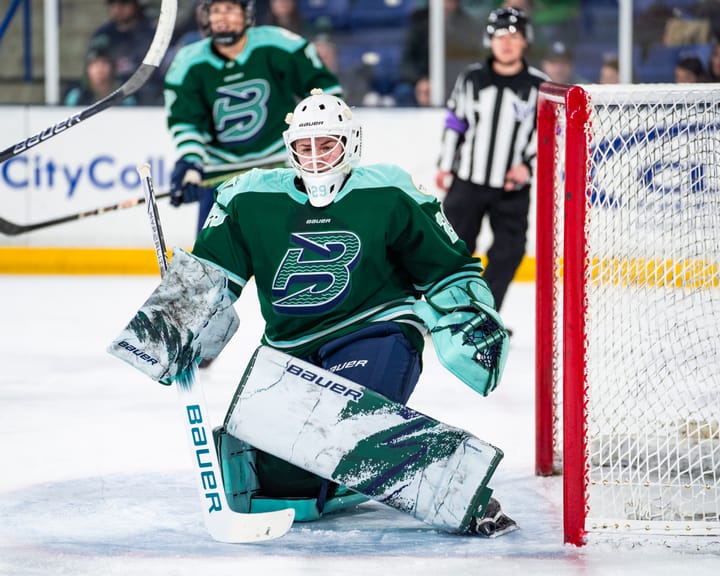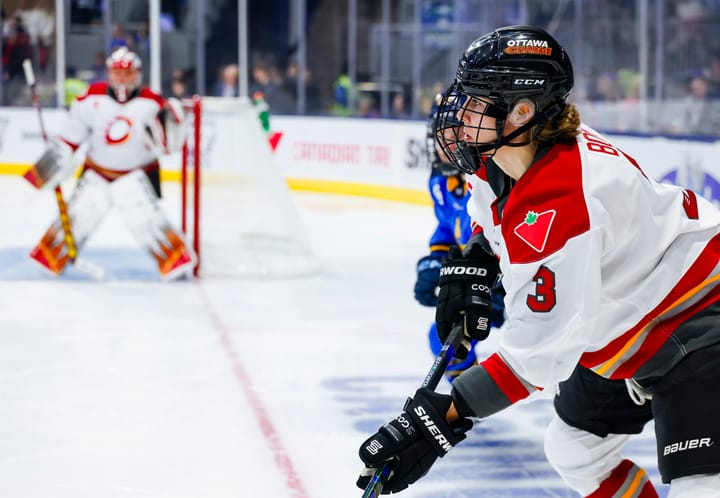Where do we play from here? Potential markets for women’s hockey expansion
Whether it’s the NWHL or a new and different league, these six cities seem like a good place to start.
Let’s assume, for the sake of argument, that the locations of the current 5 NWHL teams are going to stay the same. There are conversations to be had about whether that can or should be the case, but that’s for another article. For purposes of this thought experiment we’ll assume that the Beauts will remain in Amherst, NY; the Pride will remain in Boston; the Whale will remain in Danbury; the Riveters will remain in western New Jersey, and the Whitecaps will remain in St. Paul.
Women’s hockey has seen various levels of success in these markets. St. Paul, Boston and the Buffalo area—whether Buffalo proper or the suburb Amherst— have proven to be very good spots for a women’s hockey team. The Riveters began as a New York team and migrated to New Jersey, and then further west in New Jersey, over the past few years. The Whale have similarly migrated, spending time closer to Boston and closer to New York, and ending up this season in Danbury, sharing a rink with the Hat Tricks of the Federal Prospects Hockey League.
So where should we put the next few women’s hockey teams, NWHL or otherwise? Well, I have a few ideas.
Milwaukee, Wisconsin
The AHL’s Milwaukee Admirals are drawing an average of 4,981 spectators this season, down from last year’s 5,412. The top-drawing AHL team this season is pulling close to 9,000 people a game, and the capacity of UW-Milwaukee Panther Arena is 12,700.
Wisconsin doesn’t have an NHL team. The Badgers programs are almost unquestionably the top draw for hockey in the state, regardless of gender. Women’s games at LaBahn sell out at least a few times each year and the women’s program, a perennial NCAA playoff team and 2019 NCAA champions, feeds into the USA Hockey program at the U18, U22 and senior levels. There’s no reason to think that people would show up to a Wisconsin team with any less fervor than people show up in St. Paul for the Whitecaps.
Why Milwaukee instead of Madison? Because the Badgers have such a draw that it would be best not to compete directly with them. Plus, it’s a bigger city, closer to Chicago and Grand Rapids, and there’s a possibility of partnering with the Admirals. The Admirals could use the hype around having a women’s team to grow their own fanbase through the cross-promotion of bonafide Badger alum superstars like Annie Pankowski and Ann-Renee Desbiens and Predators prospects like Eeli Tolvanen and Thomas Novak.
Grand Rapids, Michigan
USA Hockey’s arena is in Plymouth, Michigan and there have been several high-profile women’s hockey events, both national team and NWHL-related, in the Detroit area over the last few years. The Griffins are the sixth-most popular team in the league by AHL attendance this season, and several notable women’s hockey players are Michigan natives, including Brittany Ott, Megan Keller, and Madison Packer.
Having a women’s team in Grand Rapids would reduce the pressure of competing against USA Hockey and USNTDP teams in Plymouth and the Red Wings in Detroit. Van Andel Arena seats 8,206 and Grand Rapids is a great fulcrum between potential teams in the upper Midwest and teams in places like Toronto and Buffalo, allowing Minnesota and Wisconsin teams to play another team closer to them before traveling further east. Not to mention, one of the foremost girls programs in the country, HoneyBaked Hockey Club is in Farmington Hills, which, while closer to Detroit, gives a potential women’s team a great potential youth partner.
Laval, Quebec
The AHL’s Laval Rocket has drawn a little over 6,000 spectators on average this season. In the CWHL’s last season, the Rocket collaborated occasionally with Les Canadiennes, and this year they partnered with the PWHPA for a double-header that had great attendance. Quebec is a no-brainer as far as expanding women’s hockey. Someone—whether it’s the NWHL or some future league—must have a team in the Montreal area. Even looking beyond Marie-Philip Poulin and her ability to draw thousands in the province on her own, a Quebec team would include countless other former Canadiennes who had already built a substantial fanbase in the area.
Placing a team in Laval instead of Montreal proper is a strategic move that would keep the team from competing directly with the Canadiens while leaving them close enough to push for a double-header in the Centre Bell. The Centre Bell itself is also a little big for a women’s hockey team, seating over 20,000 as opposed to the Place Bell, which seats 10,000. With time and dedicated marketing, plus the cross-promotion possibilities with a partner like the Rocket, it’s not unthinkable that a Laval women’s hockey team could near capacity at Place Bell, especially against a Boston or Toronto team.
Brampton, Ontario
The Brampton and Markham Thunder did not draw particularly strong crowds, in the grand scheme of things, but the issues leading to a depleted crowd can be addressed. For one, although there are many talented GTA-born and GTA-based players, it might be smart for now to keep the Toronto-area market condensed into one team to maximize its name recognition. The Thunder had to compete with the Furies, who had names like Spooner and Nurse on their roster and branding that matched the beloved Leafs.
The other big fix is the kind of marketing reach and capabilities a women’s team might be able to get if partnered with, say, the ECHL’s Brampton Beast. The ECHL is not the AHL, surely, but it’s an established professional league with at least some resources and structure. The Beast are one of a few men’s teams who should be asking for a women’s team. They’re second-to-last in the ECHL in attendance this year, drawing, on average, only 2,089 spectators per game.
We already know that a Toronto-area team with someone like Natalie Spooner or Sarah Nurse on the roster can pull more of a crowd than that if it’s well-marketed. The Beast play at the CAA Center, which holds 5,000 people. 5,000 is a reachable number for a condensed Ontario team, particularly for a game with rivalry implications like one against a Quebec team or a Buffalo team.
Providence, Rhode Island
Almost every Boston women’s hockey team assembled has been unfairly, ridiculously stacked. Even the erstwhile Boston (later Worcester) Blades were a real problem back in the pre-NWHL days, because the US Women’s National Team players tended to all play in Boston. Now that there’s only one women’s professional team in the greater Boston area again, we’re seeing the same pattern. Boston, with its wealth of NCAA Division I programs and as a generally attractive place for young people to live, is a city whose talent pool could use a little dilution. For now, the Whale are much closer to New York City than to Boston, which doesn’t help the Pride Problem.
What would help? A team in Providence. Players can live and work in Boston and play in Providence. The Friars already have a presence in the NWHL with names like Corinne Buie and Christina Putigna, and splitting teams like Northeastern, Harvard, BU and BC up into Providence vs. Boston would increase the parity of any league and allow more players from and around the area to compete for more spots on rosters. It would also alleviate some of the headache of travel, giving a team from, say, Minnesota, a more extended road trip that makes a 3-hour flight feel a little bit more worth it.
The Providence Bruins have drawn almost 7,500 people a game this year. The Dunkin’ Donuts Center fits 12,400 and could easily support a women’s team. As an added bonus, the Boston Bruins have been bought in as a partner to the NWHL’s Pride for over a year now, and Dunkin’ itself has sponsored both the NWHL and a handful of PWHPA showcases in the US, so we can be fairly confident that there are similar partnerships to be made in Providence as well.
Pittsburgh, Pennsylvania
A women’s hockey team in Pittsburgh is overdue. The Penguins have done a truly impressive job supporting women’s hockey at all levels over the past few years, from hosting the first-ever Battle at the Burgh NCAA tournament this season to hosting Team USA and Team Canada in November and hosting several NWHL events— the 2016-2017 All Star Game, a regular-season game between the Whale and Beauts in January 2018, and regular-season game between the Whale and Riveters in December 2018. All of these events have done very well in terms of attendance, and the Penguins organization itself has done a great job supporting the needs surrounding these games, including marketing.
I find it hard to believe that a full-time team would do any worse. With programs like Robert Morris, Penn State and Mercyhurst, and a great location that can tie Minnesota, Wisconsin, Michigan to Buffalo, New Jersey and the further-east teams, the ‘Burgh is the place to be. It could be next on the NWHL’s list, but if it isn’t, someone needs to put a team there, stat.
Honorable Mentions:
Calgary, Alberta: A little too far for this thought experiment, but sorely missed as a women’s hockey market.
San Diego, California: Also too far, but would be a great spot for a team in a world with unlimited money and player salaries over a $100,000 minimum.
Norfolk, VA: Just a little bit too far south compared to the other teams I chose, but Virginia and the DC area should get a shot at a neutral-ground game or exhibition, and soon.
Cleveland, Ohio: The AHL Monsters have the highest attendance in the league this season, drawing nearly 9,000 people a game. Plus, why not? What else are people going to do, go watch the Browns? Get real.





Comments ()